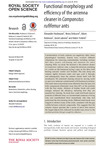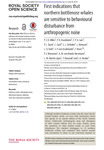Search
Now showing items 1-10 of 14
Surface drag reduction and flow separation control in pelagic vertebrates
(2015)
Living in water imposes severe constraints on the evolution of the vertebrate body. As a result of these constraints, numerous extant and extinct aquatic vertebrate groups evolved convergent osteological and soft-tissue ...
An advanced shape-fitting algorithmapplied to quadrupedal mammals
(2015)
Body mass is a fundamental physical property of an individual and has enormous bearing upon ecology and physiology. Generating reliable estimates for body mass is therefore a necessary step in many palaeontological studies. ...
Frog tongue acts as muscle-powered adhesive tape
(2015)
Frogs are well known to capture fast-moving prey by flicking their sticky tongues out of the mouth. This tongue projection behaviour happens extremely fast which makes frog tongues a biological high-speed adhesive system. ...
Mechanical analysis of avian feet
(2015)
The grasping capability of birds’ feet is a hallmark of their evolution, but the mechanics of avian foot function are not well understood. Two evolutionary trends that contribute to the mechanical complexity of the avian ...
Functional morphology and efficiency of the antenna cleaner in Camponotus rufifemurants
(The Royal Society, 2015)
Contamination of body surfaces can negatively affect many physiological functions. Insects have evolved different adaptations for removing contamination, including surfaces that allow passive self-cleaning and structures ...
First indications that northern bottlenose whales are sensitive to behavioural disturbance from anthropogenic noise
(The Royal Society, 2015)
Although northern bottlenose whales were the most heavily hunted beaked whale, we have little information about this species in its remote habitat of the North Atlantic Ocean. Underwater anthropogenic noise and disruption ...
Evidence for a pervasive ‘idling-mode’ activity template in flying and pedestrian insects
(The Royal Society, 2015)
Understanding the complex movement patterns of animals in natural environments is a key objective of ‘movement ecology’. Complexity results from behavioural responses to external stimuli but can also arise spontaneously ...
Heat dissipation during hovering and forward flight in hummingbirds
(2015)
Flying animals generate large amounts of heat, which must be dissipated to avoid overheating. In birds, heat dissipation is complicated by feathers, which cover most body surfaces and retard heat loss. To understand how ...
Proprioceptive feedback determines visuomotor gain in Drosophila
(2016)
Multisensory integration is a prerequisite for effective locomotor control in most animals. Especially, the impressive aerial performance of insects relies on rapid and precise integration of multiple sensory modalities ...
Can differential nutrient extraction explain property variations in a predatory trap?
(2015)
Predators exhibit flexible foraging to facilitate taking prey that offer important nutrients. Because trap-building predators have limited control over the prey they encounter, differential nutrient extraction and trap ...










